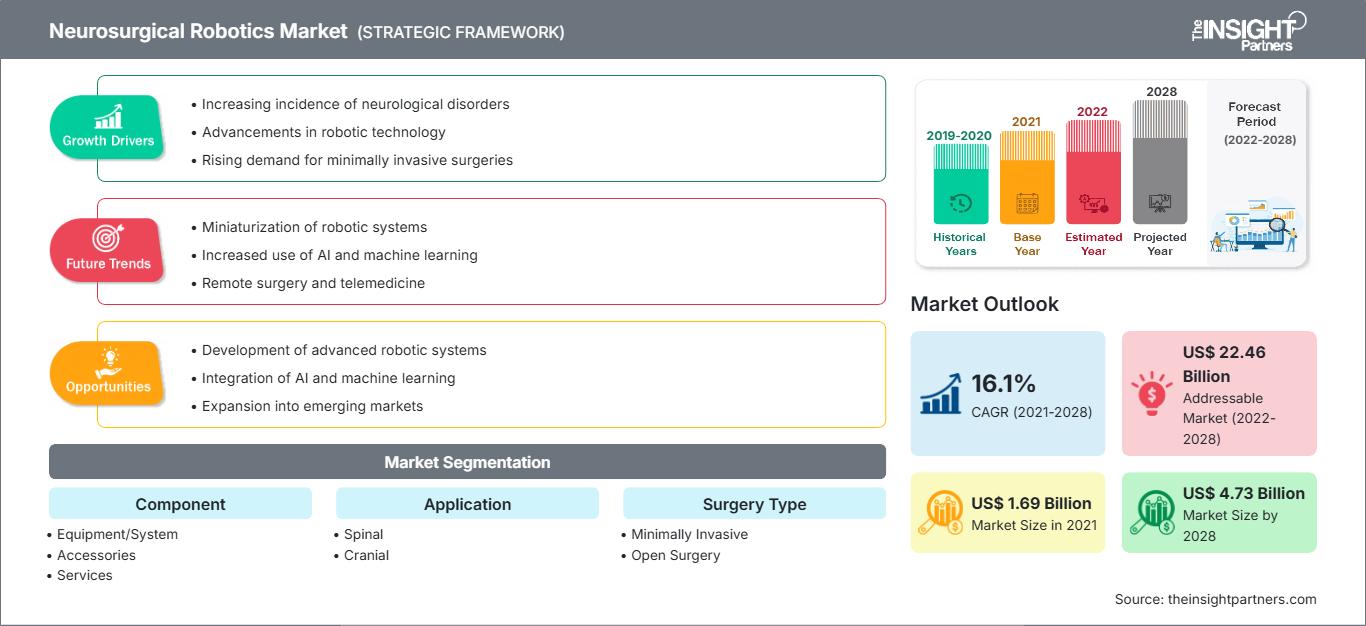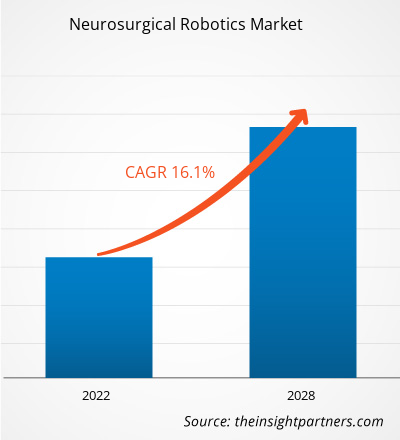Le marché de la robotique neurochirurgicale devrait passer de 1 691,02 millions de dollars américains en 2021 à 4 729,86 millions de dollars américains en 2028. On estime qu'il connaîtra un TCAC de 16,1 % entre 2022 et 2028.
Un robot est un appareil mécanique automatique ressemblant souvent à un humain ou à un animal. Les robots modernes sont généralement des machines électromécaniques guidées par un programme informatique ou des circuits électroniques. Les robots peuvent être autonomes ou semi-autonomes et vont des humanoïdes tels que l'Advanced Step in Innovative Mobility (ASIMO) de Honda et le TOSY Ping Pong Playing Robot (TOPIO) de TOSY aux robots industriels, aux robots en essaim programmés collectivement et même aux nanorobots microscopiques. Au cours des 20 dernières années, les robots neurochirurgicaux ont de plus en plus contribué aux interventions neurochirurgicales. Ces dernières années, des robots neurochirurgicaux ont été développés pour réaliser diverses interventions. La demande du public influence l'orientation de la neurochirurgie et exerce une pression accrue sur les neurochirurgiens pour qu'ils utilisent des robots neurochirurgicaux. La diversité et la sophistication croissantes des robots neurochirurgicaux ont fait l'objet d'un examen éthique approfondi en raison des complications chirurgicales potentielles et du rôle futur des robots.
Le rapport offre un aperçu et une analyse approfondie du marché mondial de la robotique neurochirurgicale, en mettant l'accent sur divers paramètres, notamment les tendances du marché, les avancées technologiques, la dynamique du marché et l'analyse du paysage concurrentiel des principaux acteurs mondiaux. Il inclut également l'impact de la pandémie de COVID-19 sur le marché dans toutes les régions. L'impact global de la COVID-19 sur le marché de la robotique neurochirurgicale a été mitigé ; par conséquent, le marché continue de gagner du terrain et devrait croître dans les années à venir. Les systèmes de santé étaient surchargés et la prestation de soins médicaux à tous les patients est devenue un défi dans la région. De plus, le secteur des dispositifs médicaux a également été confronté aux effets indésirables de cette pandémie. Alors que la pandémie de COVID-19 continuait de se propager, les fabricants de dispositifs médicaux ont éprouvé des difficultés à gérer leurs opérations. De nombreuses entreprises de robotique neurochirurgicale étaient implantées aux États-Unis et ont été affectées par les effets d'une épidémie généralisée de COVID-19. Cependant, après la normalisation des restrictions liées à la pandémie, le volume d'interventions chirurgicales est revenu à la normale. Progressivement, les hôpitaux ont commencé à reprendre les interventions non urgentes, le taux de guérison de la COVID-19 augmentant la demande d'équipements médicaux comme les robots neurochirurgicaux.
Vous bénéficierez d’une personnalisation sur n’importe quel rapport - gratuitement - y compris des parties de ce rapport, ou une analyse au niveau du pays, un pack de données Excel, ainsi que de profiter d’offres exceptionnelles et de réductions pour les start-ups et les universités
Marché de la robotique neurochirurgicale: Perspectives stratégiques

- Obtenez les principales tendances clés du marché de ce rapport.Cet échantillon GRATUIT comprendra une analyse de données, allant des tendances du marché aux estimations et prévisions.
Informations géographiques
Sur le plan géographique, le marché mondial de la robotique neurochirurgicale est segmenté en Amérique du Nord (États-Unis, Canada et Mexique), Europe (France, Allemagne, Royaume-Uni, Espagne, Russie, Italie et reste de l'Europe), Asie-Pacifique (Chine, Inde, Japon, Australie, Corée du Sud, Kazakhstan et reste de l'APAC), Moyen-Orient et Afrique (Arabie saoudite, Émirats arabes unis, Afrique du Sud et reste de la région MEA) et Afrique du Sud et Moyen-Orient et Afrique du Nord. Amérique centrale (Brésil, Argentine et reste de l'Amérique du Sud et centrale).
Aperçu du marché
Augmentation du nombre d'interventions neurochirurgicales
La prévalence croissante des troubles neurologiques, notamment l'épilepsie, la maladie de Parkinson, les traumatismes crâniens, les tumeurs cérébrales, les accidents vasculaires cérébraux et l'hydrocéphalie, accroît le besoin de neurochirurgie. De plus, plusieurs sous-spécialités de la neurochirurgie, telles que la neurochirurgie pédiatrique, la neurochirurgie fonctionnelle, la chirurgie neurovasculaire, la traumatologie, la chirurgie de la base du crâne et la chirurgie de la colonne vertébrale, comptent parmi les domaines de la chirurgie les plus techniques et les plus spécialisés.
Selon un article intitulé « Souligner le rôle de la neurochirurgie dans la santé mondiale et les systèmes de santé nationaux », Selon une étude publiée dans Frontiers Media SA en 2021, en raison de l'incidence croissante des traumatismes crâniens (TC) et de l'hydrocéphalie, 22,6 millions de personnes dans le monde ont besoin de soins neurologiques chaque année. Parmi ces patients, 13,8 millions nécessitent une neurochirurgie. Selon les données publiées par les Centres pour le contrôle et la prévention des maladies (CDC), les États-Unis ont enregistré environ 223 135 hospitalisations liées à des traumatismes crâniens en 2019 et 64 362 décès en 2020. De plus, selon un article publié en 2022 dans The Lancet intitulé « The future research path of traumatic brain injury », plus de 27 millions de nouveaux cas de traumatismes crâniens sont signalés chaque année dans le monde. Les traumatismes crâniens peuvent être traités par des interventions neurochirurgicales. Par conséquent, l'augmentation des cas de traumatismes crâniens due à plusieurs facteurs, notamment les chutes, les blessures sportives, les accidents de la route, la violence domestique et les incidents militaires, stimule la demande d'interventions neurochirurgicales.
Selon les données de l'Organisation mondiale de la santé (OMS) publiées en juin 2022, environ 50 millions de personnes souffrent d'épilepsie dans le monde, l'une des maladies neurologiques les plus courantes. Près de 80 % des patients épileptiques vivent dans des pays à revenu faible ou intermédiaire. De plus, on estime que 5 Chaque année, des millions de personnes reçoivent un diagnostic d'épilepsie. Les patients qui répondent mal aux traitements médicamenteux subissent une intervention chirurgicale. Par conséquent, l'incidence croissante de l'épilepsie accroît le besoin d'interventions neurochirurgicales. Ainsi, l'augmentation du nombre d'interventions neurochirurgicales stimule la croissance du marché de la robotique neurochirurgicale.
Informations basées sur les composants
Le marché mondial de la robotique neurochirurgicale est segmenté en équipements, accessoires et services. En 2021, le segment des accessoires représentait la plus grande part de marché. Cependant, le segment des services devrait enregistrer le TCAC le plus élevé du marché entre 2022 et 2028.
Informations basées sur les applications
Le marché mondial de la robotique neurochirurgicale est divisé en deux catégories : rachidienne et crânienne. Le segment rachidien détenait une part de marché plus importante en 2021 et devrait enregistrer un TCAC plus rapide au cours de la période de prévision. période.
Marché de la robotique neurochirurgicale
Marché de la robotique neurochirurgicale
Les tendances régionales et les facteurs influençant le marché de la robotique neurochirurgicale tout au long de la période de prévision ont été analysés en détail par les analystes de The Insight Partners. Cette section aborde également les segments et la géographie du marché de la robotique neurochirurgicale en Amérique du Nord, en Europe, en Asie-Pacifique, au Moyen-Orient et en Afrique, ainsi qu'en Amérique du Sud et en Amérique centrale.
Portée du rapport sur le marché de la robotique neurochirurgicale| Attribut de rapport | Détails |
|---|---|
| Taille du marché en 2021 | US$ 1.69 Billion |
| Taille du marché par 2028 | US$ 4.73 Billion |
| TCAC mondial (2021 - 2028) | 16.1% |
| Données historiques | 2019-2020 |
| Période de prévision | 2022-2028 |
| Segments couverts |
By Composant
|
| Régions et pays couverts | Amérique du Nord
|
| Leaders du marché et profils d'entreprises clés |
|
Densité des acteurs du marché de la robotique neurochirurgicale : comprendre son impact sur la dynamique commerciale
Le marché de la robotique neurochirurgicale connaît une croissance rapide, portée par une demande croissante des utilisateurs finaux, due à des facteurs tels que l'évolution des préférences des consommateurs, les avancées technologiques et une meilleure connaissance des avantages du produit. Face à cette demande croissante, les entreprises élargissent leur offre, innovent pour répondre aux besoins des consommateurs et capitalisent sur les nouvelles tendances, ce qui alimente la croissance du marché.
- Obtenez le Marché de la robotique neurochirurgicale Aperçu des principaux acteurs clés
Informations basées sur l'utilisateur final
Le marché mondial de la robotique neurochirurgicale est segmenté en fonction de l'utilisateur final : hôpitaux, centres spécialisés et autres. Le segment des hôpitaux détenait la plus grande part de marché en 2021. Il devrait enregistrer le TCAC le plus élevé du marché entre 2022 et 2028.
Les acteurs du marché mondial de la robotique neurochirurgicale adoptent des stratégies organiques, notamment le lancement et l'expansion de produits, pour étendre leur présence et leur portefeuille de produits à l'échelle mondiale et répondre à la demande croissante. Les principaux acteurs du marché sont Globus Medical, Inc., Renishaw plc, Accuray Incorporated, NuVasive, Inc., Brainlab AG, Zimmer Biomet, Synaptive Medical, Inc., Medtronic, Brain Navi Biotechnology Co., Ltd. et B. Braun Melsungen AG.
- Analyse historique (2 ans), année de base, prévision (7 ans) avec TCAC
- Analyse PEST et SWOT
- Taille du marché Valeur / Volume - Mondial, Régional, Pays
- Industrie et paysage concurrentiel
- Ensemble de données Excel
Rapports récents
Rapports connexes
Témoignages
Raison d'acheter
- Prise de décision éclairée
- Compréhension de la dynamique du marché
- Analyse concurrentielle
- Connaissances clients
- Prévisions de marché
- Atténuation des risques
- Planification stratégique
- Justification des investissements
- Identification des marchés émergents
- Amélioration des stratégies marketing
- Amélioration de l'efficacité opérationnelle
- Alignement sur les tendances réglementaires






















 Obtenez un échantillon gratuit pour - Marché de la robotique neurochirurgicale
Obtenez un échantillon gratuit pour - Marché de la robotique neurochirurgicale